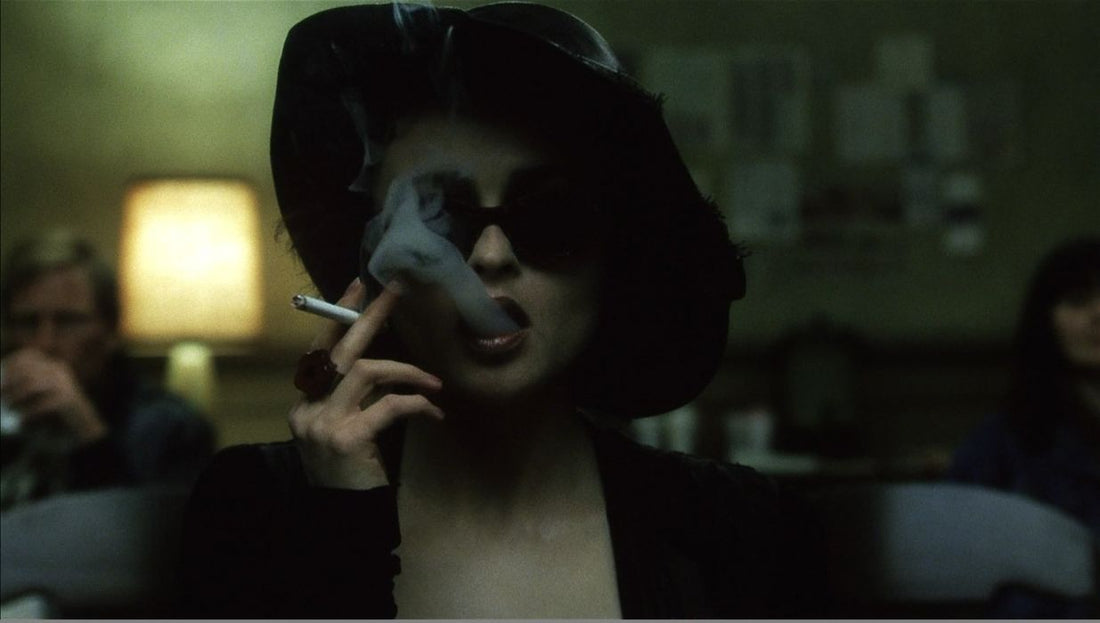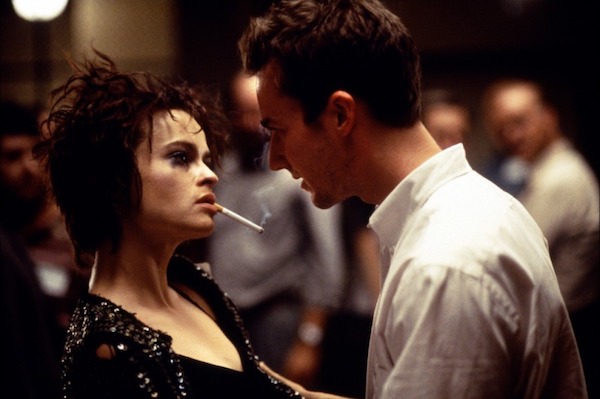On Helena Bonham-Carter’s birthday, we’re spotlighting a role the actress brought vital humanity to – despite being the only woman in a nightmarish man’s world. Beth Piket writes on Marla Singer and the legacy of Fight Club.
Leaping from vanity to violence in a bold confrontation of matters that had become parasitical to 1990s America, David Fincher offered his own contribution to the canon of cultural masterpieces with Fight Club. The film is admired for both its incendiary critique of consumerism and as an unapologetic satire of traditional masculinity in crisis, but when reflecting upon the brilliance of Fight Club, the celebration of women is often neglected. Critic Jans Wager described hectic love interest Marla Singer (Helena Bonham-Carter) as ‘necessary but peripheral’, and whilst the former is true yet wildly understated, the latter is plainly unjust. In Fincher’s microcosm of irrepressible egoism that leads one man to exist between two selves, Marla becomes a figure of pragmatism that allows the reappearance of reality. This is a depiction of playground bravado escalating to pandemic chaos, and to scapegoat Marla as the catalyst, or worse, to label her hardly influential at all, would be far too easy.
With her arrival announced by the echo of sharp high heels, Marla enters through a fog of cigarette smoke, masked by sunglasses and smothered in scarlet lipstick. Priming expectations for suffering to come, her appearance comes as a deliberate revival of the noir-era femme fatale, an ominous and ruthlessly vicious figure who not only revels in the expression of her sexuality, but actively uses it to deceive men for personal gain. The Narrator (Edward Norton) is living out a falsehood; struggling with insomnia, he attends support groups for illnesses he doesn’t have as the emotional release helps him sleep. Marla exposes him as a fraud through her presence alone, as her attendance of a testicular cancer group hardly represents a case of legitimacy either. She’s immediately posed to cause trouble, but not by simply seeking annihilation of the male lead. Evading the launch of a targeted attack on men, instead she succeeds in establishing her own emotional boot-camp, coaching on all things empathy, love and relationships.
The Narrator harbours a severe self-hatred and social ineptitude which has hindered his ability to maintain functional relationships, both romantic and platonic. Tyler (Brad Pitt), his alter ego, laments how they’re part of a ‘generation of men raised by women’ categorising women as one oppressive collective that single-handedly eradicated masculine authority. Marla becomes inconsistent with his generalisations – the accomplice to Fincher’s satire, she ridicules the ignorance.
And so, the audience must begin to familiarise themselves with this chaotic woman who refuses branding as the enemy. The Narrator’s intrigue and eventual romantic attraction to her doesn’t necessarily extend to the audience; this infatuation is not ours, and we’re supposed to be able to remove his rose-tinted glasses and perceive her potential oddities. Part of recognising her peculiarity comes with acknowledging her androgyny, where she’s able to simulate stereotypical masculinity in self-centred decision-making and a lack of physical self-care, while still maintaining contact with performative femininity via her indulgence in pink tulle dresses – and yet she still remains an outcast on both sides. There’s daintiness as much as dirtiness in Marla.
When she has sex, these are not heavenly moments of love-making, but bouts of brutal, animalistic pleasure-seeking. The instances of hyperbole are only further accentuated by a dildo that sits quietly on her dresser, a kind of nonchalant manifestation of her impenitent indulgence in her own sexuality. It might pose a threat to the Narrator’s ability to satisfy her sexually, taunting him as some kind of off-hand castration metaphor, or it might not. It could be as profound as a paralleling crisis of femininity, where women appear to have lost touch with their desire for actual men, or it could be far simpler. Truthfully, it just feels like a very unpretentious, very primal enjoyment of sex. Marla is frank about her sexual selfishness, only concerned with her own pleasure, and Fincher allows her command over her own sexual freedom without the burden of uncomfortable objectification.
It’s only when Tyler inflicts a chemical burn onto the Narrator that a true shift in Marla becomes apparent – directly mirroring the Narrator’s gradual discarding of Tyler. Writhing in unfathomable agony, he visualises Marla as what he calls his ‘power animal’ in his frantic pursuit of comfort. It’s enlightenment, in which the Narrator recognises her as the embodiment of all that he idolises about Tyler whilst rejecting all that he despises, from a denouncement of materialism to the effortless confidence – she is who he wants to be. The fitting shape of the burn has something of the branding of vulva, a permanent shaming of emasculation, but this picture of psychological turmoil speaks louder as an epiphany whereby sexual fantasy gives way to a tangible future, of which, Marla is the foundation.
Marla becomes tantamount to the notion of living life ordinarily, personifying the bridge from mental decline to the sweet normalcy of the everyday romance, and she educates the Narrator on how to be in love. Clichés of the teen romance arise in her character when her adoration for the Narrator begins to intensify; she lays on her bed clutching the telephone as she chatters with her sweetheart, and she cares about his response when she enters the room in her new dress. The anarchy dwelling in Marla’s own mind is pacified by the possibility of mutual dependence, and her relationship with the Narrator endures a shift of focus as it becomes centred around emotional sustenance as opposed to carnal sexual desire. She asks him to examine her for breast cancer, demonstrating both dependency and a need for non-sexual touch, and in return he offers his craving for affection, his face softening as she kisses his cheek.
Upon this unexpected yearning for Marla, the Narrator’s mental health deteriorates – he lacks any coping ability, but this was never her fault. When she finally calls attention to his dual personality – it serves as the final extermination of his self-doubt, and his affliction – epitomised by Tyler – dissipates. When he eventually murders Tyler, the Narrator purges himself of any apprehensions he entertained about his capacity to live unperturbed; his prejudices against any who may further jeopardise his social ranking, and where this plague once ruled him, he’s now without restriction.
Where the Narrator once vented his uncontainable loathing via cataclysmic carnage, he abandons it in exchange for the first real chance at human connection – and he binds his decision by taking Marla’s hand. The image evokes an incarnation of Adam and Eve as the pair come together, reborn in their discovery of empathy, and it feels as though all is as it should be. It’s barbaric to watch the city crumble of your own volition without remorse, but there’s an undeniable regality as they observe, detached from society with their heads held high. It’s somehow soothing, and somewhat romantic as the skyline twinkles and the explosions crackle like fireworks. Beneath the cacophony of moral messages and the surge of emotion unleashed with the sounding of the Pixies, one thing remains clear – this is an unearthing of freedom, a gateway to happiness, and we see Marla at the epicentre.
When the audience first met her, Marla was an apathetic narcissist, and yet by the conclusion of Fight Club, she’s dictated by unmasked vulnerabilities and has dedicated her entire being to someone else, subjecting herself to his warpath. The turbulent progress of her character might suggest that personal suffering is best avoided by maintaining the emotional distance she once demonstrated, but alternatively, her narrative can be construed as an exhibition of of the sheer courage it demands to become unguarded against love, rejection and failure. Marla grows to be ostensibly paradoxical, and she softens in a way that seems implausible at first glance. But, to depict a woman with incongruities is not necessarily to render her as pliant, nor submissive. Marla is free to change her mind and develop with her situation, to learn about herself, to act as any regular, feeling person would if faced with the same tribulation. She may highlight the subjugation of women, but this is not about weakness in the face of men, this is about the intrinsic craving for reciprocity – where it’s not a flaw, but the very route to emotional satisfaction.
At the beginning of Fight Club, the Narrator asserts that Marla is ‘at the root’ of his regression, but she comes to prove the opposite to be true. Through her impulsive temperament where ever-impending chaos meets an underlying tenderness, she strikes the sweet spot that incentivises the Narrator’s return to reality. Marla is able to sate his niche appetite for a life rooted in security, but not radically devoid of frivolous thrill. She becomes his avenue to balance, to bliss – and and indeed she is, the very root of his survival.
Beth Piket (@bethanypiket) is a part-time Film Studies undergraduate, part-time master of chaotic organisation from south-east England. Interests include coming-of-age cinema and Andrea Arnold films, or preferably a combination of the two.
READ ME is a platform for female-led writing on film commissioned by Girls on Tops. Louisa Maycock (@louisamaycock) is Commissioning Editor and Ella Kemp (@efekemp) is Contributing Editor.



.jpg)